#plantarchy
Text
In the future, children will think our ways are strange. "Why do old people always grow so much milkweed in their gardens?" they'll say. "Why do old people always write down when the first bees and butterflies show up? Why do old people hate lawn grass so much? Why do old people like to sit outside and watch bees?"
We will try to explain to them that when we were young, most people's yards were almost entirely short grass with barely any flowers at all, and it was so commonplace to spray poisons to kill insects and weeds that it was feared monarch butterflies and American bumblebees would soon go extinct. We will show them pictures of sidewalks, shops, and houses surrounded by empty grass without any flowers or vegetables and they will stare at them like we stared at pictures of grimy children working in coal mines
79K notes
·
View notes
Text
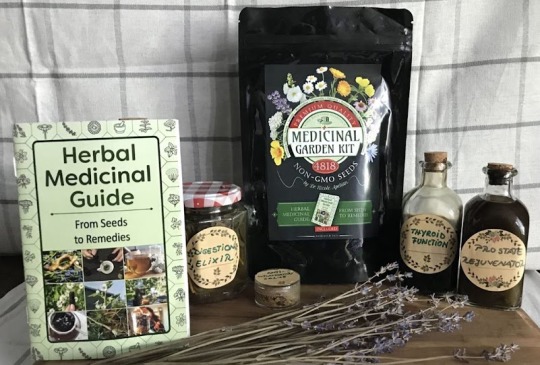
Do you want to learn the Best way to grow a medicinal garden? Go Here.
In ancient times, civilizations revered the earth as the ultimate healer, cultivating gardens teeming with medicinal plants. From the fertile banks of the Nile to the lush mountains of China, botanical medicine flourished, offering remedies for a myriad of ailments. These gardens were not just patches of greenery; they were sanctuaries of healing and vitality, where the wisdom of nature was revered and cherished. Today, the tradition lives on as modern herbalists and gardeners alike continue to harness the power of medicinal plants to promote health and well-being. The origins of the medicinal garden are rooted in the timeless wisdom of our ancestors, reminding us of the profound connection between humanity and the natural world.
#plants#indoor plants#outdoor plants#garden#gardening#backyard#house plant#plantlife#plantbased#herbs#medicinal plants#medicinal garden#flowers#gardens#nature#nature core#native plants#ecology#environment#home and garden#gardenblr#plantarchy#conservation#outdoors
1 note
·
View note
Text


the irony of keeping these cuttings in this bag while my hands are covered in tiny cactus splinters
#plantarchy#trypophobia tw#idk it doesn't really bother me to look at but i could see it being a thing so I'm gonna tag it
11 notes
·
View notes
Note
i always end up referring to you as mewgician,,
For some reason this reminds me that I always think of @plantanarchy as "plantarchy."
6 notes
·
View notes
Photo

@_.plantarchy._ wearing the Black & Pink Halloween Bats Shorts 🦇🖤💗🦇 ★ ★ ★ 𝗦𝗛𝗢𝗣 𝗡𝗢𝗪 ★ TOOFAST.COM ★ ★ ★ #occult #occultfashion #halloweenstyle #halloween #punkclothes #punkstyle #punkfashion #punkrock #witchfashion #altfashion #gothclothing #alternativefashion #altclothing #goth #gothaesthetic #instagoth #gothicstyle #gothsofinstagram #gothstyle #glamgoth #gothfashion #darkfashion #darkclothing #punk #punksnotdead #rocknroll #alternativestyle #edgyfashion #alternative #witchyclothes
#toofast#toofastclothing#punkclothing#gothclothing#occultfashion#pastelgoth#pastelgothclothing#witchvibes#witchbitch#witches#witchesofinstagram#witchyclothing#witchyfashion#punkfashion#altfashion#altclothing#goth
0 notes
Note
i get what you're saying but im not really concerned with what people think. iwas dismissive of plantanarchys presumptions that he knows whats best and knows what the entire trans community feels or wants. he resorted to personal insults, not me. all i did was refer to a former man as "he". not once have i ever disrespected an individuals request to be called he or she, no one has ever made that request,& plantanarchy is the first to make that request for the whole, which isnt his place.
I’m not concerned with the insults at all, and this isn’t really a hill either of us should die on because neither of us are affected by transphobia.
As such, he’s not a former woman, and Chelsea isn’t a former man; I understand you’re trying to be ‘rational’ about this, but you’re glossing over the agency of these individuals to shape their own existence, define their own experiences, and express their preferences. When Chelsea expressed the same four years ago, it was through her lawyer at the time in a statement clearly outlining her preference for such.
Your predilection for referring to Chelsea as Bradley isn’t really your place, you know? plantanarchy’s post doesn’t even mention Manning by name, but was clearly in the context of such misgendering on a post which, as far as I can tell, you weren’t even the originator of! You instead chimed in with your opinion in an effort to have what you call a rational discussion, but it seems highly irrational to me to interject on a topic in which I have no horse racing. In that particular exchange, you expressed that it was your opinion that [transgender] people should:
not [let] petty thing like that upset you, there are far more important things to be concerned with
Your apparent concern for Bre (and the entire trans community) aside, you then inexplicably injectManning into the discussion
Chelsea manning was a man and you dont get to speak for her or anyone else. let people decide for themselves.
Chelsea did decide for herself. Four years ago (probably more). It is incredibly disrespectful, I think, to present your unsolicited opinion on an existence you admit you do not experience:
but i dont pretend to know how all trans people feel, or to know that all trans people would be offended, its mighty hubris to think you know whats in the mind of a entire demographic
Which of course isn’t what plantarchy did here:
y’all just refer to trans people by their preferred pronouns even when talking about them in the past when they didn’t use those pronouns it is very simple and respectful and will save you and them a lot of grief. i get being ignorant or confused about that or fumbling over words and some fuckups are to be expected, but it’s not so hard really
It’s not really a presumption, and he’s not claiming to speak on behalf of anyone. With his kind of lived experience though, his thoughts certainly carry more weight in these matters and this is just one of many voices that you have no doubt seen expressing this similar sentiment. Your response…didn’t really contribute anything? You dismissed this type of experience as a “petty thing”.This is the rational discussion you want to have, even after admitting you can’t pretend to know how anyone in the trans community might feel? Here is one person from that community, presenting you with general advice (not even in that annoying, patronizing insulting tumblr way) and even some relief for those among us who struggle to grasp the changing social nuances… you went out of your way to punctuate your interjection (on a his post reflecting his and other trans experiences) by calling him the disrespectful one for suggesting that this might be something that contributes to continued emotional trauma.
I think its a little disingenuous to then come back with the notion that you just wanted some rational discussion. Yeah you got some insults hurled your way but for someone who wants to maintain the facade of civility, you didn’t keep it up for very long. You got roasted by a whole squad, and couldn’t even pretend to respect women long enough to forget you can’t just call people petnames and think it doesn’t come off as chauvinist.
but this is just my Hot Take™
11 notes
·
View notes
Photo

PLANTARCHY!
Her name is Dandelion, her agenda is ... only known to her. She is maybe something like an eco punk and loves to make moss street art! Her rat is called Stinker.
14 notes
·
View notes
Text
it's definitely my predisposition to extreme frugality+redneck engineering, but i'm now obsessed with creating things literally without buying Anything. no supplies no tools no nothing, only the stuff you can just find outside, like Plants, Sticks, and Rocks.
I'm making textiles with nothing but foraged plant materials using no tools except sticks. Nature allows you to do this! There's no rules! I mean okay well maybe there might be some rules sometimes but they're just weak human rules! The plants themselves? They're like "Why sure! You can make yarn with nothing but fibers from the dead stem I don't need anymore, a couple sticks from that tree over there, and your own body and mind! Why not?"
Plants like to give us gifts! And nobody has the power to stop them!
18K notes
·
View notes
Text
Mom sent me a facebook link to a PBS news hour post about how the anti-lawn movement is growing. The vast majority of the comments on it were stuff like this:


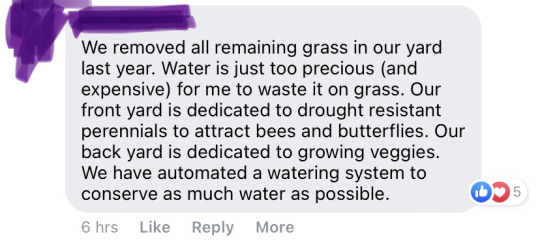
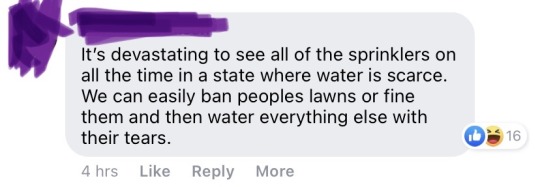
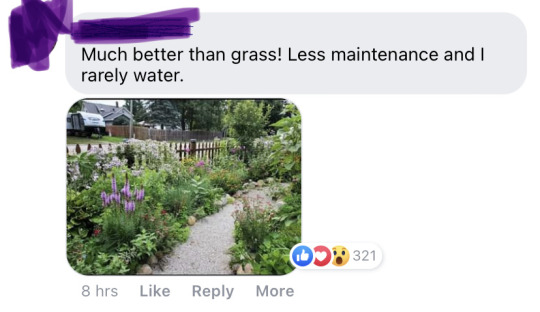


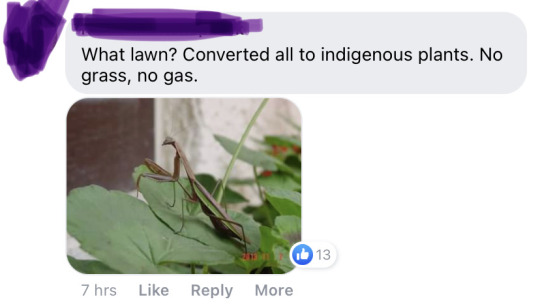
Most people are on our side here, even the so-called "boomers." We just have to be spreading ecological knowledge and practical means of creating useful habitat in back yards! Educate! Protect! Resist!
56K notes
·
View notes
Text
The USAmerican imagination cannot consider land that is multi-purpose.
A corn field is Corn, an endless monoculture, and all other plants must be eliminated. A residential area is Houses, and absolutely MUST NOT!!! have vegetables or fruits or native plant gardens or small livestock. A drainage ditch is only a drainage ditch, and cannot harbor Sedges and native wetland plants, A sports field is for A Sport, and let no one think of doing any other event on that field, shops and storefronts must have their own special part of town that everybody has to drive to, which requires parking lots...and God forbid we put solar panels on roofs or above parking lots or anywhere they can serve an extra purpose of providing shade, instead of using a large tract of perfectly fine land as a "solar farm."
Numerous examples. But it is the most annoying with agriculture. The people who crunch all the numbers about sustainability, have calculated that a certain percentage of Earth's land is "Used up" by agriculture, which is troubling because that leaves less "room" for "Wilderness." It is a big challenge, they say, to feed Earth's humans without destroying more ecosystems.
Fools! Agriculture is an ecosystem—if you respect the ways of the plants, instead of creating monoculture fields by killing everything that moves and almost everything that doesn't. Most humans throughout history, and many humans today, sustain themselves using a mixture of foraging and agriculture, and the two are not entirely different things, because all human lifestyles change the ecosystem, and the inhabitants of the ecosystem always change themselves in response.
Even if you are a hunter-gatherer that steps very lightly in the forest and gathers a few berries and leaves here and there, you are being an animal and affecting all other parts of the ecosystem. By walking, breathing, eating, pooping, drinking, climbing, singing, talking, all of those things affect the ecosystem. If you gather leaves to sleep on, that affects the ecosystem...if you pile up waste, that affects the ecosystem...if you break a tree branch, that affects the ecosystem...if you start a fire, if you create a small shelter, if you cut a path, that DEFINITELY affects the ecosystem.
This idea, that human activity destroys the ecosystem and replaces it with something Else, something Not an ecosystem, is so silly. "But you just said that even the earliest most technologically simple human societies altered their environment!"
Yes, I did. Because we believe that "pre-agricultural" humans could have no effect on their "wilderness" environment, we ALSO believe another false idea: That when humans affect an environment, they destroy "Wilderness" and change it to something else, like Agricultural Land, that can never have biodiversity and never benefit many life forms.
I think it is the European idea of agriculture that it always involves people settling down and relying on a few special plants that are domesticated intentionally and grown in specially dedicated fields. After all, this idea of an agricultural lifestyle, is in contrast with the "hunter-gatherer" lifestyle, which is assumed to be what humans do before they "figure out" agriculture. The European mind imagines "pre-agricultural" folks ignorantly bumbling about, thinking plants and animals conveniently pop out of nothing for their benefit.
Bullshit! I shake my head in disappointment when I see websites describing Native Americans using wild plants as if those plants just-so-happened to grow, when those same wild plants just-so-happen to thrive only in environments disturbed by humans in some way, and just-so-happen to have declined steeply since colonization, and just-so-happen to be nonexistent in unspoiled "Wilderness" locations, and (often) just-so-happen to have an incredibly wide range where they either once were or are incredibly common, making it very...fortunate that they just-so-happen to have a wide range of uses including food, medicines, and materials for clothing and technology.
Accidentally of course, without any human impact from the humans that were impacting everything. /s
"But if it wasn't an accident, how did it happen?" Here is how to understand this idea: Look at the weeds! The weeds will teach you.
Look at the plants you always see growing without being planted around human buildings and roads, and learn their history. Often you will learn that these plants have many marvelous properties, and have actually been used by humans for thousands of years.
In fact, some of the most powerful and difficult to control weeds, were once actually some of the most essential and important plants for human civilizations to depend on. The dreaded Kudzu, in its home in East Asia, was one of the main plants used for clothing for over 6,000 years, and not only that, it has been cultivated for food and medicine for millennia. You can make everything from paper to noodles out of Kudzu! And Amaranth, the most expensive agricultural weed in all the USA, produces edible and healthy grains as well as several harvests of greens per growing season, and several species of the genus have been fully domesticated and formed a staple crop of Mesoamerica.
Meanwhile...some people have come up with this neat "new" idea called Polyculture, which is where you plant a field with two crops at once and somehow get better yields from both of them. WITCHCRAFT! Unrelatedly, there are other ideas like "Cover Crops" and "Agroforestry" that for some reason have the same beneficial effect.
Wow...It turns out, sterilizing the whole environment of every plant except one crop...isn't actually a good way to do agriculture in many places in the world.
Just think about it from an energy point of view...
We have some places used for "Agriculture," where we wring the land as violently as possible to squeeze green vegetation from light energy.
And we have other places for Other uses, where we spend massive amounts of fossil fuels mowing, chopping, poisoning and trimming to STOP the land from producing its incredible bounty of green vegetation.
And in the agricultural fields, we spend even MORE resources killing the unwanted plants that grow spontaneously
This system is hemorrhaging inefficiency at both ends. It simply isn't a one-to-one conversion of land and fossil fuels to food energy. The energy expenditure of agriculture is mostly going into organizing the vegetation's energy into the shape and configuration we want, not the food itself.
In the Americas, indigenous agricultural systems involve using the plants that exist in the environment to construct an ecosystem that both functions as an ecosystem and provides humans with food, clothing, and other important things. This is the most advanced way.
Most of our successful weeds are edible and useful. A weed is simply a plant that is symbiotic with humans. My hypothesis of plant domestication is that it was initiated by the plants, which became adapted to human environments, and humans bred them to be better crops in response. Symbiosis.
Humans did not pick out a few plants special to intensively domesticate out of an array of equally wild plants, instead they just ate, selected, and bred the plants that were best adapted to live near human civilization. That is my guess about how it happened.
Just think about it. Why would you try to domesticate teosinte (Maize ancestor?) It sucks. Domesticated plants in their wild form are usually like "Why would you put hundreds of years of effort into cultivating this?" Personally I think it's because the plant grew around humans and humans ate and used it a lot because it was abundant. So we co-evolved with the plant.
Supporting this hypothesis, there are many crop plants that mutated and evolved back into weeds, like "weedy" rice, "weedy" teosinte, and "weedy" radishes. Also weeds develop similar adaptations to crop plants to survive in the agricultural environment.
Consider Kudzu. Everyone in the USA knows it as an invasive weed, but since ancient times in China, it was a crop that provided people with fabric from its bast fibers, food from its enormous starchy roots, and many medicinal and other uses. Kudzu is not evil, it simply has a symbiotic relationship with humans, and just as any other species might serve as a biological control, the main biological control of kudzu in nature is the human species.
Think of the vast fields and mountain sides of the South swallowed by thick mats of Kudzu covering lumps that used to be trees. Think of the people toiling away to clear the Kudzu, while wearing clothes made of cotton that was grown in a faraway place using insecticides and depleting fresh water, using energy from their bodies that came from crops grown in fields far away.
Now imagine people working to harvest the Kudzu, to cut the new vines and dig up the starchy roots and use the plant the way it is used by the people who know its ways. Imagine the people using the starch from the Kudzu root to make flour and noodles and sweet confections. Imagine workers processing the vines into thread which is woven into fabric. The hillsides and fields flourish with plants that used to be suffocated, and hillsides and fields in faraway places also flourish with their own plants, instead of being made to grow cotton and crops to provide for the needs the Kudzu provides for.
Imagine the future where we accept our symbiotic relationship with the plants!
3K notes
·
View notes
Text
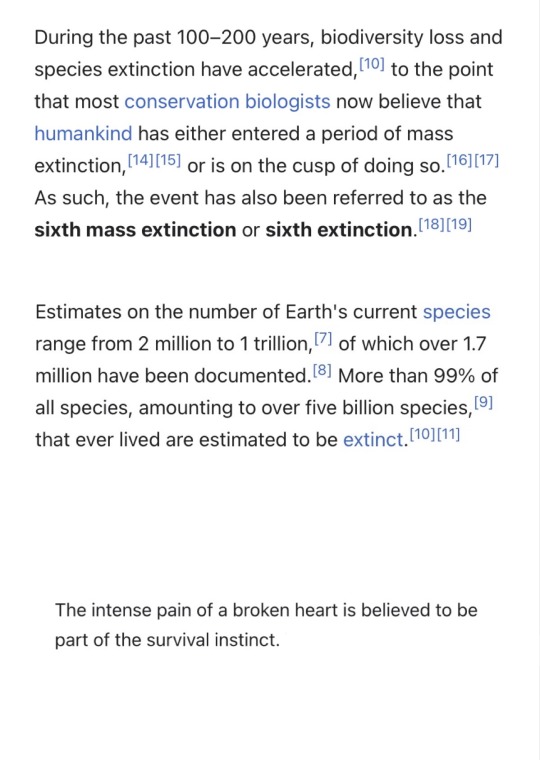
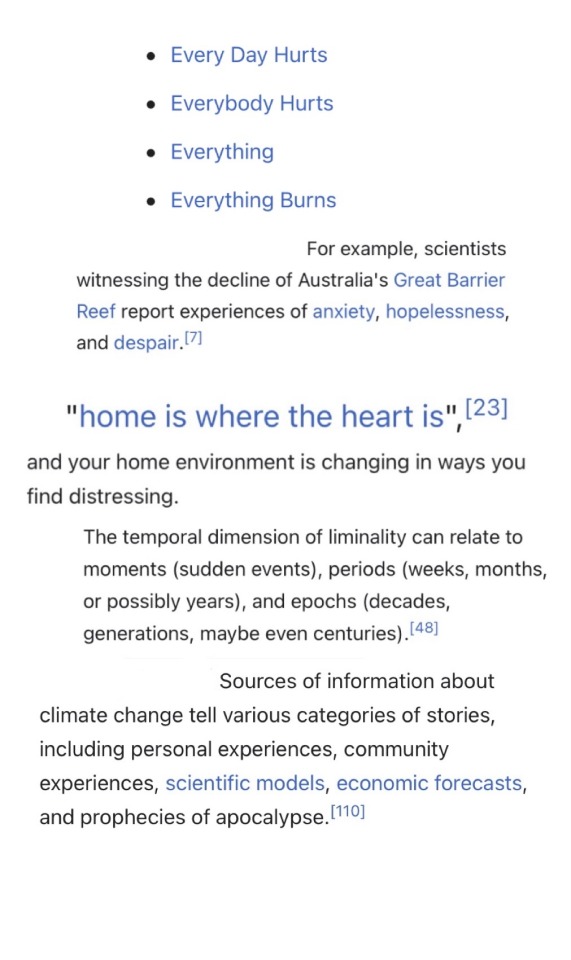

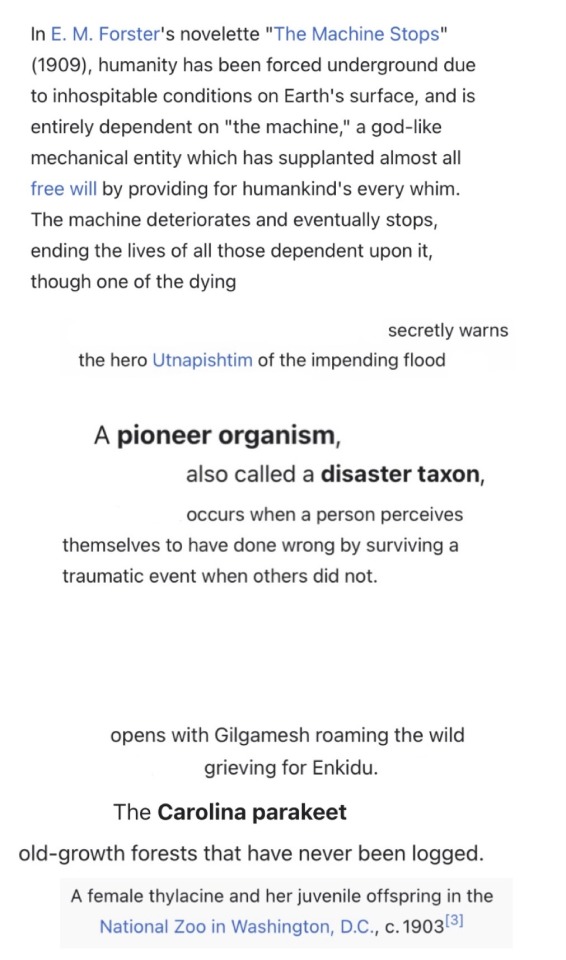


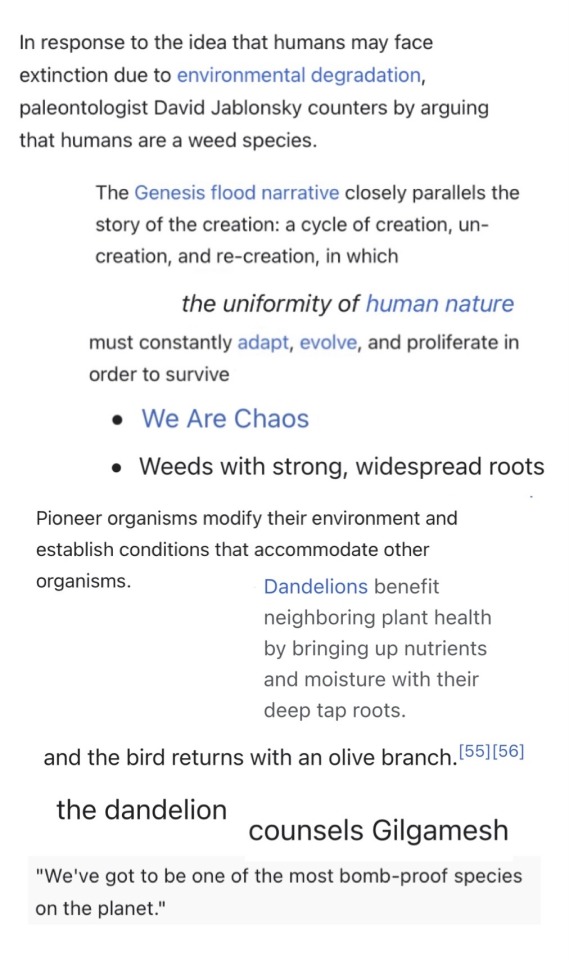
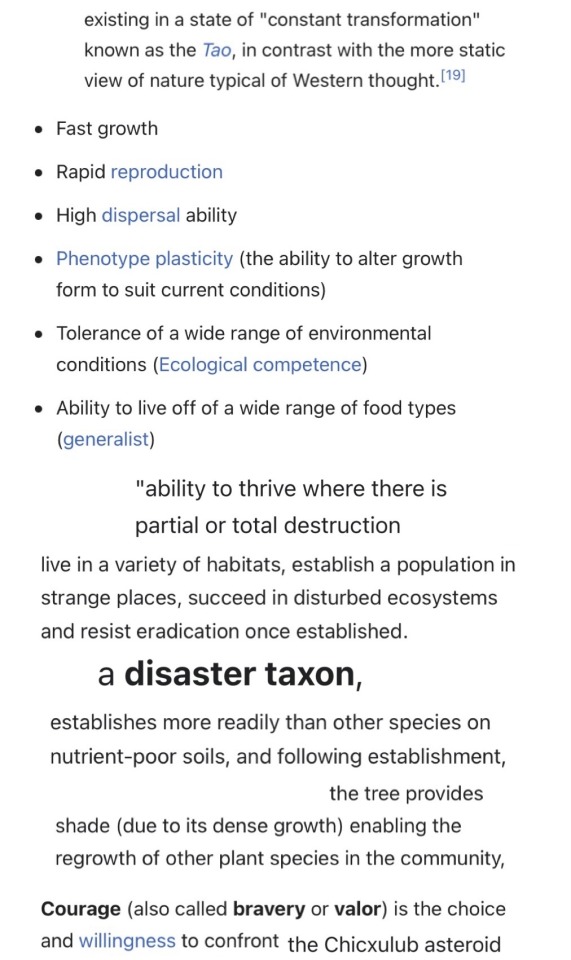

"Disaster Taxon," poem assembled using text from Wikipedia articles
#wikipedia poem#wikipedia poetry#climate grief#grief#environmental grief#resilience#climate change#gilgamesh#flood narrative#post apocalyptic#poetry#my writing#wikipedia poems#weeds#plantarchy#mass extinction#dandelion#utnapishtim
12K notes
·
View notes
Text
There, in the sunlit forest on a high ridgeline, was a tree I had never seen before.
I spend a lot of time looking at trees. I know my beech, sourwood, tulip poplar, sassafras and shagbark hickory. Appalachian forests have such a diverse tree community that for those who grew up in or around the ancient mountains, forests in other places feel curiously simple and flat.
Oaks: red, white, black, bur, scarlet, post, overcup, pin, chestnut, willow, chinkapin, and likely a few others I forgot. Shellbark, shagbark and pignut hickories. Sweetgum, serviceberry, hackberry, sycamore, holly, black walnut, white walnut, persimmon, Eastern redcedar, sugar maple, red maple, silver maple, striped maple, boxelder maple, black locust, stewartia, silverbell, Kentucky yellowwood, blackgum, black cherry, cucumber magnolia, umbrella magnolia, big-leaf magnolia, white pine, scrub pine, Eastern hemlock, redbud, flowering dogwood, yellow buckeye, white ash, witch hazel, pawpaw, linden, hornbeam, and I could continue, but y'all would never get free!
And yet, this tree is different.
We gather around the tree as though surrounding the feet of a prophet. Among the couple dozen of us, only a few are much younger than forty. Even one of the younger men, who smiles approvingly and compliments my sharp eye when I identify herbs along the trail, has gray streaking his beard. One older gentleman scales the steep ridge slowly, relying on a cane for support.
The older folks talk to us young folks with enthusiasm. They brighten when we can call plants and trees by name and list their virtues and importance. "You're right! That's Smilax." "Good eye!" "Do you know what this is?—Yes, Eupatorium, that's a pollinator's paradise." "Are you planning to study botany?"
The tree we have come to see is not like the tall and pillar-like oaks that surround us. It is still young, barely the diameter of a fence post. Its bark is gray and forms broad stripes like rivulets of water down smooth rock. Its smooth leaves are long, with thin pointed teeth along their edges. Some of the group carefully examine the bark down to the ground, but the tree is healthy and flourishing, for now.
This tree is among the last of its kind.
The wood of the American Chestnut was once used to craft both cradles and coffins, and thus it was known as the "cradle-to-grave tree." The tree that would hold you in entering this world and in leaving it would also sustain your body throughout your life: each tree produced a hundred pounds of edible nuts every winter, feeding humans and all the other creatures of the mountains. In the Appalachian Mountains, massive chestnut trees formed a third of the overstory of the forest, sometimes growing larger than six feet in diameter.
They are a keystone species, and this is my first time seeing one alive in the wild.
It's a sad story. But I have to tell you so you will understand.
At the turn of the 20th century, the chestnut trees of Appalachia were fundamental to life in this ecosystem, but something sinister had taken hold, accidentally imported from Asia. Cryphonectria parasitica is a pathogenic fungus that infects chestnut trees. It co-evolved with the Chinese chestnut, and therefore the Chinese chestnut is not bothered much by the fungus.
The American chestnut, unlike its Chinese sister, had no resistance whatsoever.
They showed us slides with photos of trees infected with the chestnut blight earlier. It looks like sickly orange insulation foam oozing through the bark of the trees. It looks like that orange powder that comes in boxes of Kraft mac and cheese. It looks wrong. It means death.
The chestnut plague was one of the worst ecological disasters ever to occur in this place—which is saying something. And almost no one is alive who remembers it. By the end of the 1940's, by the time my grandparents were born, approximately three to four billion American chestnut trees were dead.
The Queen of the Forest was functionally extinct. With her, at least seven moth species dependent on her as a host plant were lost forever, and no one knows how much else. She is a keystone species, and when the keystone that holds a structure in place is removed, everything falls.
Appalachia is still falling.
Now, in some places, mostly-dead trees tried to put up new sprouts. It was only a matter of time for those lingering sprouts of life.
But life, however weak, means hope.
I learned that once in a rare while, one of the surviving sprouts got lucky enough to successfully flower and produce a chestnut. And from that seed, a new tree could be grown. People searched for the still-living sprouts and gathered what few chestnuts could be produced, and began growing and breeding the trees.
Some people tried hybridizing American and Chinese chestnuts and then crossing the hybrids to produce purer American strains that might have some resistance to the disease. They did this for decades.
And yet, it wasn't enough. The hybrid trees were stronger, but not strong enough.
Extinction is inevitable. It's natural. There have been at least five mass extinctions in Earth's history, and the sixth is coming fast. Many people accepted that the American chestnut was gone forever. There had been an intensive breeding program, summoning all the natural forces of evolution to produce a tree that could survive the plague, and it wasn't enough.
This has happened to more species than can possibly be counted or mourned. And every species is forced to accept this reality.
Except one.
We are a difficult motherfucker of a species, aren't we? If every letter of the genome's book of life spelled doom for the Queen of the Forest, then we would write a new ending ourselves. Research teams worked to extract a gene from wheat and implant it in the American chestnut, in hopes of creating an American chestnut tree that could survive.
This project led to the Darling 58, the world's first genetically modified organism to be created for the purpose of release into the wild.
The Darling 58 chestnut is not immune, the presenters warned us. It does become infected with the blight. And some trees die. But some live.
And life means hope.
In isolated areas, some surviving American Chestnut trees have been discovered, most of them still very young. The researchers hope it is possible that some of these trees may have been spared not because of pure luck, but because they carry something in their genes that slows the blight in doing its deadly work, and that possibly this small bit of innate resistance can be shaped and combined with other efforts to create a tree that can live to grow old.
This long, desperate, multi-decade quest is what has brought us here. The tree before me is one such tree: a rare survivor. In this clearing, a number of other baby chestnut trees have been planted by human hands. They are hybrids of the Darling 58 and the best of the best Chinese/American hybrids. The little trees are as prepared for the blight as we can possibly make them at this time. It is still very possible that I will watch them die. Almost certainly, I will watch this tree die, the one that shades us with her young, stately limbs.
Some of the people standing around me are in their 70's or 80's, and yet, they have no memory of a world where the Queen of the Forest was at her full majesty. The oldest remember the haunting shapes of the colossal dead trees looming as if in silent judgment.
I am shaken by this realization. They will not live to see the baby trees grow old. The people who began the effort to save the American chestnut devoted decades of their lives to these little trees, knowing all the while they likely never would see them grow tall. Knowing they would not see the work finished. Knowing they wouldn't be able to be there to finish it. Knowing they wouldn't be certain if it could be finished.
When the work began, the technology to complete it did not exist. In the first decades after the great old trees were dead, genetic engineering was a fantasy.
But those that came before me had to imagine that there was some hope of a future. Hope set the foundation. Now that little spark of hope is a fragile flame, and the torch is being passed to the next generation.
When a keystone is removed, everything suffers. What happens when a keystone is put back into place? The caretakers of the American chestnut hope that when the Queen is restored, all of Appalachia will become more resilient and able to adapt to climate change.
Not only that, but this experiment in changing the course of evolution is teaching us lessons and skills that may be able to help us save other species.
It's just one tree—but it's never just one tree. It's a bear successfully raising cubs, chestnut bread being served at a Cherokee festival, carbon being removed from the atmosphere and returned to the Earth, a wealth of nectar being produced for pollinators, scientific insights into how to save a species from a deadly pathogen, a baby cradle being shaped in the skilled hands of an Appalachian crafter. It's everything.
Despair is individual; hope is an ecosystem. Despair is a wall that shuts out everything; hope is seeing through a crack in that wall and catching a glimpse of a single tree, and devoting your life to chiseling through the wall towards that tree, even if you know you will never reach it yourself.
An old man points to a shaft of light through the darkness we are both in, toward a crack in the wall. "Do you see it too?" he says. I look, and on the other side I see a young forest full of sunlight, with limber, pole-size chestnut trees growing toward the canopy among the old oaks and hickories. The chestnut trees are in bloom with fuzzy spikes of creamy white, and bumblebees heavy with pollen move among them. I tell the man what I see, and he smiles.
"When I was your age, that crack was so narrow, all I could see was a single little sapling on the forest floor," he says. "I've been chipping away at it all my life. Maybe your generation will be the one to finally reach the other side."
Hope is a great work that takes a lifetime. It is the hardest thing we are asked to do, and the most essential.
I am trying to show you a glimpse of the other side. Do you see it too?
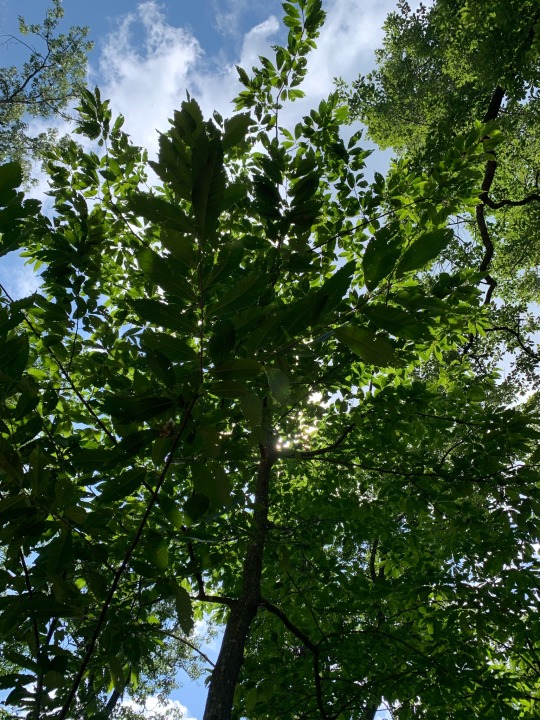
#american chestnut#hope#climate change#biodiversity crisis#climate crisis#trees#plantarchy#learning to imagine the future
3K notes
·
View notes
Text
Many people, especially USAmericans, are very resistant to knowing the plants and living according to the ways of the plants. They lash out with a mix of arrogance and fear: "Don't you know what bad things would happen if we lived a different way? There is a REASON for living this way. Would you have us go Back—backward to the time without vaccines or antibiotics????"
Ah, yes, the two immutable categories that all proposals for change fit into: Backward Change and Forward Change! Either we must invent a a futuristic, entirely new solution with SCIENCE and TECHNOLOGY that further industrializes and increases the productivity of our world, or we must give up vaccines and antibiotics and become starving illiterate medieval peasants.
Every human practice anywhere on Earth that has declined, stopped, or become displaced by another practice, was clearly objectively worse than whatever replaced it. You see, the only possible reason a way of life could decline or disappear is that it sucked and had it coming anyway!!! Pre-industrial human history is worthless except as a cautionary tale about how miserable we would all be without *checks notes* factories, fossil fuels and colonialism. Obviously!
Anyway, who do you think benefits from the idea that pesticide-dependent, corporate-controlled industrialized monoculture farming liberates us all from spending our short, painful lives as filthy, miserable peasants toiling in the fields?
First of all, I think it's silly to act like farming is a uniquely awful way to live. I can't believe I have to say this, but the awful part of being a medieval peasant was the oppression and poverty, not the fact that harvesting wheat is a lot of work and cows are stinky. Same goes for farm labor in the modern USA: the bad part is that most people working farms are undocumented migrant workers that are getting treated like garbage and who can't complain about it because their boss will rat them out to ICE.
Work is just work. Any work has dignity when the people doing it are paid properly and not being abused. Abuse and human trafficking is rampant in agriculture, but industrialization and consolidation of small farms into gigantic corporate owned farms sure as hell isn't making it better.
Is working on a farm somehow more miserable than working in a factory, a fast food restaurant, or a retail store? Give me a break. "At least I'm not doing physical labor in the sun," you say, at your job where you're forced to stand on concrete for 8 hours and develop chronic pain by age 24.
When you read about small farmers going out of business because of huge corporations, none of them are going "Yay! Now that Giant Corporation has swallowed up all the farms in the area, we can all enjoy the luxurious privileges of the industrial era, like working RETAIL!" What you do see a lot of is farmers bitterly grieving the loss of their way of life.
And also, the fact is, sustainable forms of polyculture farming that create a functional ecosystem made up of many different useful and edible plants are actually way MORE efficient at producing food than a monoculture. The reason we don't do it as much, is that it can't be industrialized where everything is harvested with machines.
Some places folks are starting to get the idea and planting two crops together in alternating rows, letting the mutualistic relationship between plants boost the yields of both, but indigenous people in many parts of the world have been doing this stuff basically forever. I read about a style of agroforestry from Central America that has TWENTY crops all together on the same field.
Our modern system of farming is necessary for feeding the world? Bullshit! Our technology is very powerful and useful, but our harmful monocultures, dangerous pesticides, and wasteful usage of land and resources are making the system very inefficient and severely degrading nature's ability to provide for us.
What is needed, is a SYNTHESIS of the power and insights of technology and science, with the ancient wisdom and knowledge gained by closely and carefully observing Nature. We do not need to reject one, to embrace the other! They should be friends!
Our system thinks land is only used for one thing at a time. Even our science often thinks this way. A corn field has the purpose of producing corn, and no other purpose, so all other plants in the corn must be killed, and it must be a monoculture of only corn.
But this means that the symbiosis between different plants that help each other is destroyed, so we must pollute the earth with fertilizers that wash into bodies of water and cause eutrophication, where algae explode in number and turn the water to green goo. Nature always has variety and diversity with many plants sharing the same space. It supports much more animal life (we are animals!) this way. The Three Sisters" are the perfect example of mutualism between plants being used in an agricultural environment. The planting of corn, beans, and squash together has been traditionally used clear across the North American continent.
And in North America, the weeds we have here are mostly edible plants too. Some of them were even domesticated themselves! Imagine a garden where every weed that pops up is also an edible or otherwise useful crop, and therefore a welcomed friend! So when weeds like Amaranth and Sunflower pop up in your field, that should not be a cause for alarm, but rather the system of symbiosis working as it should.
A field of one single crop is limited in how much it can produce, because one crop fits into a single niche in what should be a whole ecosystem, and worse, it requires artificial inputs to make up for what the rest of the plant community would normally provide. The field with twenty crops does not produce the same amount as the monoculture field divided in twenty ways, but instead produces much more while being a habitat for wild animals, because each plant has its own niche.
2K notes
·
View notes
Text
This is approximate since calculations vary, but somewhere in the neighborhood of 20% of carbon emissions since the Industrial Revolution have come from destruction of terrestrial ecosystems—wetland destruction, deforestation, degradation of grasslands and so on
Soil, soil communities, root systems, carbonate rock, wood, living plants, and peat in wetlands—all holds carbon
Now consider what plants do for you
The mere sight of plants and trees improves mental and physical health. I won't elaborate much more upon this, the positive effects are incredible and overwhelming.
Trees and vines that shade your home and outdoor areas: reduce the cost of cooling, meaning less electricity is used. Shade reduces the risk of death in extreme heat events.
(Trees also reduce light and noise pollution)
Edible plants (many wild plants and many plants you can grow): provide you with food reducing your dependence on industrial agriculture and cars to reach supermarkets
Community gardens and orchards: creates resilience and interdependence among small local communities, reducing the power of capitalism and increasing the ability of individuals to organize and create change. Makes more sustainable and plant based diets accessible to people for whom they would ordinarily be inaccessible
Compost piles for gardening: less greenhouse gas emissions than result from waste breaking down anaerobically in landfills
No more traditional lawns: much less use of gas powered lawn mowers, weed whackers etc. which are, by themselves, significant contributions to carbon emissions and urban pollution
Crafting and creating using plants: Locally available wild plant species can be used by local crafters and creators for baskets and containers, yarn, fabrics, dyes, and the like, resulting in less dependence on unsustainable and unethical global industries
More people growing and gathering edible and useful plants and using them = larger body of practical, scientific and technological insights to draw from in order to solve future problems
In conclusion: Plants
#plants#plantarchy#you are a caretaker#climate change#climate change mitigation#climate change adaptation#gardening#community gardens
3K notes
·
View notes
Text
dandelion facts:
Stories about dandelions can be found in folklore almost worldwide!
Dandelions have a diuretic effect (they make you pee,) which is reflected in some of their common names (piss-a-bed)
most North American dandelions reproduce asexually by apomixis, creating loads of identical daughters!
Since they reproduce asexually, these dandelions don't need to be pollinated, even though they produce lots of pollen and nectar. The dandelions that pop up in a lawn feed pollinators without receiving any benefit for themselves.
Dandelion seeds can sprout at any temperature between 0 and 36 degrees Celsius!
Dandelions can regenerate themselves from just a piece of their taproot!
dandelions have a near worldwide distribution and were introduced to North America as a food crop!
Dandelions grow bigger and produce more viable seeds in conditions of higher carbon dioxide, suggesting that human-caused carbon emissions are good news for the dandelions!
Dandelions have been shown to pass epigenetic changes to their DNA caused by stress to their offspring.
4K notes
·
View notes
Text
listen...Plants Are Free. an acorn will become a tree. Fallen leaves will become rich soil. The wild creatures and plants will come. You don't have to give them money.
I say this, not to deny that land, soil, seeds, and water are all made into commodities, but as a WAY OF RESISTANCE
The plants are your allies. They are fighting back every day, endlessly, clawing to return to the pavement and hard eroded ground, the abandoned lots and gravel piles left behind by the pointless and endless pursuit of profit. They are giving us seeds and nuts and acorns as gifts. The dandelions and blackberries are given to us freely by abandoned and neglected ground. Here, take this fruit and eat. Here, take these acorns and plant them. Here, take these leaves and protect and build the soil. Rest in my shade. Breathe my breath.
What do we do to survive the horrible machine, the wasteland, the all-devouring dragon? Listen to the plants. Observe them closely, learn their ways, and all of us, each of us, do the smallest things we can to be caretakers—grow and distribute the seeds, learn the names of trees and common wildflowers, protect the smallest patches of resistance in neglected corners of our neighborhoods. Take photos of any plant not planted by human hands, honoring the dignity of weeds. In the future, there will be no word for "gardener," because we will all be caretakers to whatever small or great extent we can.
5K notes
·
View notes